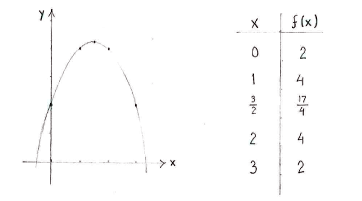Lösung 1.3:2b
Aus Online Mathematik Brückenkurs 2
(Unterschied zwischen Versionen)
K (Solution 1.3:2b moved to Lösung 1.3:2b: Robot: moved page) |
|||
| Zeile 1: | Zeile 1: | ||
| - | + | Lokale Extrempunkte einer Funktion sind entweder: | |
| - | # | + | # stationäre Punkte, wo <math>f^{\,\prime}(x)=0</math>, |
| - | # | + | # Singuläre Punkte, wodie Funktion nicht ableitbar ist, oder |
| - | # | + | # Endpunkte. |
| - | + | Wir untersuchen alle drei Fälle: | |
<ol> | <ol> | ||
| - | <li> | + | <li>Die Ableitung von <math>f(x)</math> ist |
{{Abgesetzte Formel||<math>f^{\,\prime}(x) = 3-2x</math>}} | {{Abgesetzte Formel||<math>f^{\,\prime}(x) = 3-2x</math>}} | ||
and becomes zero when <math>x=3/2\,</math>.</li> | and becomes zero when <math>x=3/2\,</math>.</li> | ||
| - | <li>The function is a polynomial, and is therefore differentiable everywhere.</li> | ||
| - | <li> | + | <li>Nachdem die Funktion ein Polynom ist, ist sie überall ableitbar.</li> |
| + | |||
| + | <li>Die Funktion ist überall definiert, und also hat unser Intervall keine Endpunkte.</li> | ||
</ol> | </ol> | ||
| - | + | Also sind alle lokalen Extrempunkte auch stationäre Punkte, und also ist <math>x=3/2\,</math> der einziger Punkt der ein Extrempunkt sein könnte. Wir untersuchen ob der Punkt ein Extrempunkt ist, mit einer Vorzeichentabelle. | |
| - | + | ||
| - | + | ||
| Zeile 40: | Zeile 39: | ||
|} | |} | ||
| - | + | Nachdem die Funktion eine quadratische Funktion ist, ist deren Graph eine Parabel mit den Maxima <math>(3/2, 17/4)</math>. | |
| - | + | ||
[[Image:1_3_2_b.gif||center]] | [[Image:1_3_2_b.gif||center]] | ||
Version vom 16:20, 26. Apr. 2009
Lokale Extrempunkte einer Funktion sind entweder:
- stationäre Punkte, wo \displaystyle f^{\,\prime}(x)=0,
- Singuläre Punkte, wodie Funktion nicht ableitbar ist, oder
- Endpunkte.
Wir untersuchen alle drei Fälle:
- Die Ableitung von \displaystyle f(x) ist
and becomes zero when \displaystyle x=3/2\,.\displaystyle f^{\,\prime}(x) = 3-2x - Nachdem die Funktion ein Polynom ist, ist sie überall ableitbar.
- Die Funktion ist überall definiert, und also hat unser Intervall keine Endpunkte.
Also sind alle lokalen Extrempunkte auch stationäre Punkte, und also ist \displaystyle x=3/2\, der einziger Punkt der ein Extrempunkt sein könnte. Wir untersuchen ob der Punkt ein Extrempunkt ist, mit einer Vorzeichentabelle.
| \displaystyle x | \displaystyle \tfrac{3}{2} | ||
| \displaystyle f^{\,\prime}(x) | \displaystyle + | \displaystyle 0 | \displaystyle - |
| \displaystyle f(x) | \displaystyle \nearrow | \displaystyle \tfrac{17}{4} | \displaystyle \searrow |
Nachdem die Funktion eine quadratische Funktion ist, ist deren Graph eine Parabel mit den Maxima \displaystyle (3/2, 17/4).

